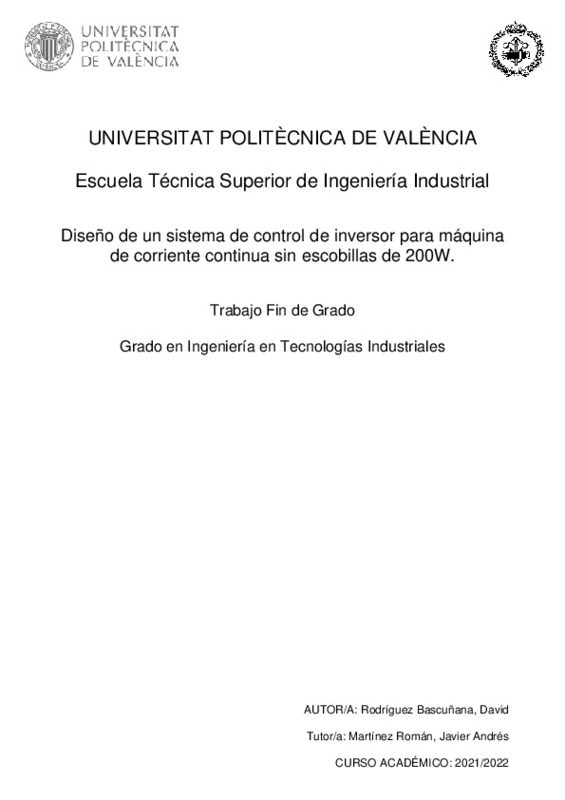JavaScript is disabled for your browser. Some features of this site may not work without it.
Buscar en RiuNet
Listar
Mi cuenta
Estadísticas
Ayuda RiuNet
Admin. UPV
Diseño de un sistema de control de inversor para máquina de corriente continua sin escobillas de 200W
Mostrar el registro sencillo del ítem
Ficheros en el ítem
| dc.contributor.advisor | Martínez Román, Javier Andrés
|
es_ES |
| dc.contributor.author | Rodríguez Bascuñana, David
|
es_ES |
| dc.date.accessioned | 2022-10-04T07:19:00Z | |
| dc.date.available | 2022-10-04T07:19:00Z | |
| dc.date.created | 2022-07-12 | |
| dc.date.issued | 2022-10-04 | es_ES |
| dc.identifier.uri | http://hdl.handle.net/10251/186884 | |
| dc.description.abstract | [ES] En la actualidad el uso de motores eléctricos de corriente continua sin escobillas (Brushless DC, BLDC) está generalizado tanto en elementos de uso cotidiano como en la industria. Por ello es una tarea fundamental el automatizar el funcionamiento de estos motores. El presente trabajo se centra en el desarrollo de un control de velocidad para un motor de este tipo. El control deberá ser seguro, impidiendo alcanzar condiciones de funcionamiento inadmisibles tanto para el motor como para los elementos que compongan el sistema de control. Además, se contempla la implementación de una interfaz de usuario compatible con dispositivos móviles Android mediante la cual se pueda regular de manera inalámbrica mediante Bluetooth la velocidad del motor, así como obtener información relevante del sistema de control en tiempo real. El sistema de control planteado se llevará cabo mediante un inversor y está basado en un microcontrolador tipo ESP32, sobre el que recaerán las tareas de control y comunicación con la interfaz de usuario. Para la operación del motor se empleará la modulación de tensión de las fases del mismo mediante el método de corriente rectangular típico de este tipo de máquinas junto con un algoritmo de modulación por ancho de pulso (PWM) por portadora triangular y control independiente de la parte positiva y negativa de cada rama del inversor. Aparte de inversor y microcontrolador, serán necesarios otros elementos, tales como sensores de corriente o posición. El proyecto contempla la identificación de este tipo de elementos y su montaje mecánico y eléctrico en el sistema. | es_ES |
| dc.description.abstract | [EN] Nowadays, the use of brushless DC electric motors (BLDC) is widespread both in everyday items and in industry. For this reason, it is a fundamental task to automate the operation of these motors. The present work focuses on the development of a speed control for a motor of this type. The control must be safe, preventing inadmissible operating conditions from being reached both for the motor and for the elements that make up the control system. In addition, the implementation of a human machine interface compatible with Android mobile devices is contemplated. This interface enables the motor speed to be regulated wirelessly via Bluetooth. Furthermore, it allows to obtain relevant information from the control system in real time. The proposed control system will use an inverter and is based on an ESP32-type microcontroller. This microcontroller will be the responsible of the control and communication tasks with the user interface. For the operation of the motor it will be used the tension modulation of the phases of the motor with the rectangular current method typical of this kind of machines together with a pulse width modulation (PWM) algorithm by triangular carrier and independent control of the positive and negative branch of the inverter. Apart from inverter and microcontroller, other elements will be necessary, such as current or position sensors. The project contemplates the identification of this type of elements and their mechanical and electrical assembly in the system. | es_ES |
| dc.format.extent | 126 | es_ES |
| dc.language | Español | es_ES |
| dc.publisher | Universitat Politècnica de València | es_ES |
| dc.rights | Reconocimiento (by) | es_ES |
| dc.subject | Control | es_ES |
| dc.subject | Inversor | es_ES |
| dc.subject | Máquina de corriente continua sin escobillas | es_ES |
| dc.subject | ESP32 | es_ES |
| dc.subject | Aplicación Android | es_ES |
| dc.subject | Inverter | es_ES |
| dc.subject | Brushless DC motor | es_ES |
| dc.subject | Android application | es_ES |
| dc.subject.classification | INGENIERIA ELECTRICA | es_ES |
| dc.subject.other | Grado en Ingeniería en Tecnologías Industriales-Grau en Enginyeria en Tecnologies Industrials | es_ES |
| dc.title | Diseño de un sistema de control de inversor para máquina de corriente continua sin escobillas de 200W | es_ES |
| dc.title.alternative | Design of an inverter control system for a 200W brushless DC machine | es_ES |
| dc.title.alternative | Disseny del sistema de control d'inversor per a máquina de corrent continu sense escombretes de 200W | es_ES |
| dc.type | Proyecto/Trabajo fin de carrera/grado | es_ES |
| dc.rights.accessRights | Abierto | es_ES |
| dc.contributor.affiliation | Universitat Politècnica de València. Departamento de Ingeniería Eléctrica - Departament d'Enginyeria Elèctrica | es_ES |
| dc.contributor.affiliation | Universitat Politècnica de València. Escuela Técnica Superior de Ingenieros Industriales - Escola Tècnica Superior d'Enginyers Industrials | es_ES |
| dc.description.bibliographicCitation | Rodríguez Bascuñana, D. (2022). Diseño de un sistema de control de inversor para máquina de corriente continua sin escobillas de 200W. Universitat Politècnica de València. http://hdl.handle.net/10251/186884 | es_ES |
| dc.description.accrualMethod | TFGM | es_ES |
| dc.relation.pasarela | TFGM\148793 | es_ES |
Este ítem aparece en la(s) siguiente(s) colección(ones)
-
ETSII - Trabajos académicos [10404]
Escuela Técnica Superior de Ingenieros Industriales






